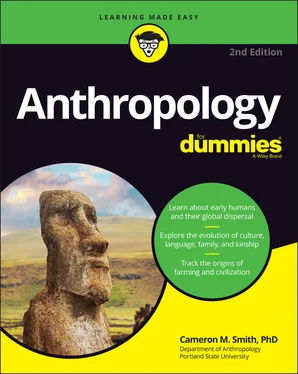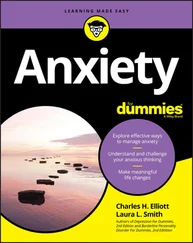 Humanity is a general term that doesn’t specify whether you’re talking about males, females, adults, or children; it simply means our species — Homo sapiens sapiens — at large. The term humanity can be applied to modern humans (Homo sapiens sapiens) as well as some of our most recent ancestors, placed more generally in Homo sapiens, without the subspecies (the second sapiens ) suffix. Exactly when Homo sapiens evolved into Homo sapiens sapiens is a complex question based on when humans became anatomically modern and when they became behaviorally modern. I introduce these questions a little later in this chapter and investigate them in detail in Chapter 7.
Humanity is a general term that doesn’t specify whether you’re talking about males, females, adults, or children; it simply means our species — Homo sapiens sapiens — at large. The term humanity can be applied to modern humans (Homo sapiens sapiens) as well as some of our most recent ancestors, placed more generally in Homo sapiens, without the subspecies (the second sapiens ) suffix. Exactly when Homo sapiens evolved into Homo sapiens sapiens is a complex question based on when humans became anatomically modern and when they became behaviorally modern. I introduce these questions a little later in this chapter and investigate them in detail in Chapter 7.
With a basic handle on what we mean by human, we need some understanding of the things that are uniquely human. An important one is culture. Culture is the whole set of information a human mind uses to describe what the world is like and what’s appropriate behavior for living in that world. Cultural differences are basically different conceptions of what is appropriate in a given situation. For example, women in traditional Tibetan culture often have more than one husband, whereas men in traditional Tajikistan (a country in central Asia) often have multiple wives. Each culture, then, has specific ideas about what’s appropriate marriage-wise, and the difference between what each considers appropriate can be surprising.
 Anthropologists often use the words society and culture interchangeably, as I do in this book. Strictly speaking, a society can contain several cultures, so it’s a larger unit than a single culture (for example, American society today encompasses Irish-American, Hispanic-American, and Japanese-American cultures, to name only three). Culture, then, includes ideas about identity (for example, what the word brother means), nature (what wild means as opposed to tame ), social relationships (how to greet the queen of England as opposed to how to greet your bowling partner), and so on.
Anthropologists often use the words society and culture interchangeably, as I do in this book. Strictly speaking, a society can contain several cultures, so it’s a larger unit than a single culture (for example, American society today encompasses Irish-American, Hispanic-American, and Japanese-American cultures, to name only three). Culture, then, includes ideas about identity (for example, what the word brother means), nature (what wild means as opposed to tame ), social relationships (how to greet the queen of England as opposed to how to greet your bowling partner), and so on.
Some anthropologists extend culture to the objects (called artifacts ) that humanity makes or uses to aid in survival. In this case, culture is both the information stored in the brain (shared among a group) and the objects that group uses to survive. For example, artifacts (also called material culture ) include the distinctive Inuit harpoon carved from bone and used to hunt seals. Not all artifacts have such obvious survival value, though. From the outsider’s perspective, the specially made drum an Arctic shaman (healer) uses in a healing ritual isn’t directly related to staying alive by hunting the landscape. But as far as the shaman is concerned, that specific drum is very important. It has to be made the right way and carry the right tone; otherwise, the healing would be jeopardized. In this way, the drum is just as important to survival as the harpoon. Note that the drum, the healing ceremony, and even the hunting harpoon are all things constructed according to the culture in a specific region. In this way, they are “cultural artifacts.”
 The idea of extending culture to encompass physical objects (artifacts) is that culture is the extrasomatic means of adaptation . That is, whereas other life forms survive via bodily ( somatic ) adaptations, humanity relies not so much on its anatomy as its culture, its extrasomatic means of adaptation and survival. I am persuaded by this approach, and I think it’s a useful concept.
The idea of extending culture to encompass physical objects (artifacts) is that culture is the extrasomatic means of adaptation . That is, whereas other life forms survive via bodily ( somatic ) adaptations, humanity relies not so much on its anatomy as its culture, its extrasomatic means of adaptation and survival. I am persuaded by this approach, and I think it’s a useful concept.
The term humanity can be a little tricky because anthropologists use it to refer to our biological species, Homo sapiens sapiens , as well as some of our most recent ancestors in the more general species Homo sapiens (lacking the very specific subspecies sapiens .) When the human species should be referred to as Homo sapiens versus Homo sapiens sapiens depends on whether you’re talking about being anatomically or behaviorally modern.
Anatomical modernity is being anatomically indistinguishable from modern, living populations. This term really comes into play only when anthropologists are looking at the bones of ancient human-like creatures and asking whether these creatures were human. Strictly speaking, if anthropologists can’t distinguish the bones they’re looking at from those of modern populations, the bones are those of an anatomically modern person.
Behavioral modernity is behaving in a way that’s indistinguishable from modern, living populations. This label also really comes into play only when anthropologists are looking at the complexity of behavior in the past — for example, at the objects made by ancient proto-humans. Asking whether the creatures that made these objects were behaviorally human is a tough question that I re-examine in Chapter 7, but for the moment it’s enough to know behaviorally modern people employ symbolism , the use of one object to stand for another. Blood, for example, is a common substance, but humanity can also use it — or its properties, such as the color red —symbolically to activate emotions, memories, and actions in other people. This uniquely human capacity for the complex use of symbols is a big part of behavioral modernity.
I explore just when and where humanity became behaviorally and anatomically modern in Chapter 7.
-Isms and the Making of Anthropology
Like most scholarly disciplines, anthropology wasn’t just tidily invented overnight; I think of it as a Frankenstein’s monster of ideas and questions culled from other disciplines, cobbled and stitched together into a more-or-less functional whole. (You can read more about the various subdisciplines of anthropology in Chapter 3.)
But even before anthropology existed as a discrete academic field, its foundations were being laid by people doing other things that would later be called anthropology (or act as guidelines for building anthropology). Herodotus, a 6th-century Greek scholar, described the peoples and antiquities of Egypt, and Julius Caesar described the people he encountered in France (the Gauls) and southern England (the Britons) in the 50s BC. And the ancient Egyptians wrote about their neighbors to the North (in the Near East) and to the South (the Nubians of modern-day Sudan); clearly, people have been interested in other people for a long time. But these reports were often curios, or passages written as political statements, and they were largely descriptive. They showed what was (more or less) but didn’t go into too much detail about why . As descriptions, they were often quite accurate — but they offered few systematic explanations for human diversity.
It wasn’t until the 19th and 20th centuries AD that people systematically went out from the centers of Western civilization (in Europe and North America) with the specific goal of studying other people. (Although there are anthropologists in just about every country today, the discipline really was a 19th-century AD invention of Europe and North America.) Rather than explaining other (non-European) people with ancient legends, or religious explanations, early anthropologists attempted a degree of objectivity, using the scientific method. It was far from perfect, and some things went wrong early in anthropology, but the seed of anthropology was watered, and a new discipline began to grow.
Читать дальше

 Humanity is a general term that doesn’t specify whether you’re talking about males, females, adults, or children; it simply means our species — Homo sapiens sapiens — at large. The term humanity can be applied to modern humans (Homo sapiens sapiens) as well as some of our most recent ancestors, placed more generally in Homo sapiens, without the subspecies (the second sapiens ) suffix. Exactly when Homo sapiens evolved into Homo sapiens sapiens is a complex question based on when humans became anatomically modern and when they became behaviorally modern. I introduce these questions a little later in this chapter and investigate them in detail in Chapter 7.
Humanity is a general term that doesn’t specify whether you’re talking about males, females, adults, or children; it simply means our species — Homo sapiens sapiens — at large. The term humanity can be applied to modern humans (Homo sapiens sapiens) as well as some of our most recent ancestors, placed more generally in Homo sapiens, without the subspecies (the second sapiens ) suffix. Exactly when Homo sapiens evolved into Homo sapiens sapiens is a complex question based on when humans became anatomically modern and when they became behaviorally modern. I introduce these questions a little later in this chapter and investigate them in detail in Chapter 7. The idea of extending culture to encompass physical objects (artifacts) is that culture is the extrasomatic means of adaptation . That is, whereas other life forms survive via bodily ( somatic ) adaptations, humanity relies not so much on its anatomy as its culture, its extrasomatic means of adaptation and survival. I am persuaded by this approach, and I think it’s a useful concept.
The idea of extending culture to encompass physical objects (artifacts) is that culture is the extrasomatic means of adaptation . That is, whereas other life forms survive via bodily ( somatic ) adaptations, humanity relies not so much on its anatomy as its culture, its extrasomatic means of adaptation and survival. I am persuaded by this approach, and I think it’s a useful concept.










